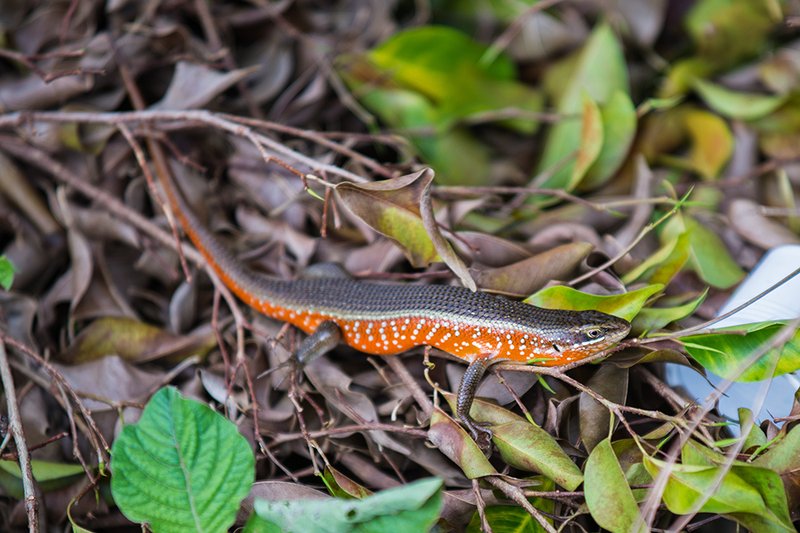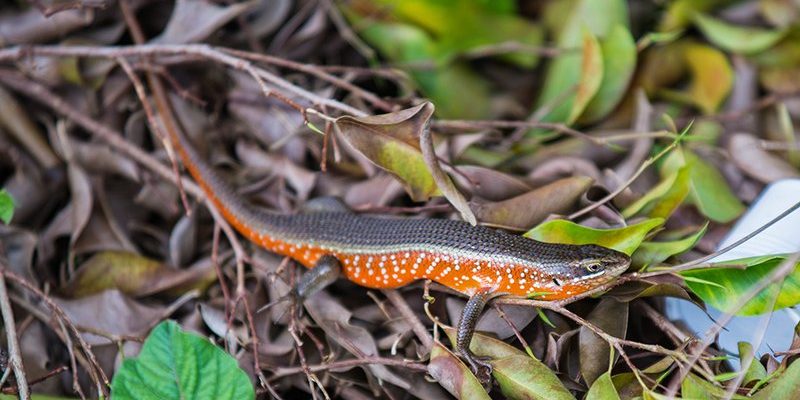
Fire skinks, with their stunning orange and black patterns, are more than just pretty faces. They have adapted to live in environments that test the limits of endurance. Let’s dive into the incredible world of these lizards and uncover how they’ve become champions of survival against nature’s toughest challenges.
Adaptations to Climate: Heat and Humidity
Fire skinks primarily inhabit the forests and savannas of Africa, where temperatures can soar and humidity fluctuates. Honestly, their first line of defense is their physical adaptations. These lizards have a unique ability to regulate their body temperature, which is crucial in a world where the sun can be punishing.
For starters, their scales are more than just for show. They help reflect sunlight, reducing heat absorption. By staying under leaves or in rocky crevices during the hottest part of the day, fire skinks can cool down and avoid dehydration. Think of it like finding a shady spot to rest when you’re feeling too hot; it’s all about managing your exposure to those intense rays.
In addition, these lizards have an interesting behavior known as basking. They’ll soak up some sun in the morning to warm up before going about their daily activities. But as the day heats up, they retreat to cooler areas, like burrows or shaded spots, to avoid overheating. This clever balance between seeking warmth and finding cool refuge is key to their survival.
Diet and Feeding Habits
Now let’s talk about what keeps a fire skink energized: its diet. These lizards are insectivores, meaning their main food sources are insects. You might be thinking, “How do they find food in such harsh conditions?” Here’s the thing: fire skinks are opportunistic feeders. They’ll hunt for whatever is available, whether it’s beetles, crickets, or worms.
Their sharp vision and quick reflexes help them catch prey efficiently. They can spot a tasty insect from a distance and dart towards it in a flash. This adaptability allows them to thrive even when food might be scarce. It’s like knowing where the best food trucks are when you’re wandering a new city—being aware of your options makes all the difference.
In times of extreme weather, like droughts, fire skinks can slow their metabolism, which reduces their need for food. This allows them to survive longer periods without eating. It’s a survival strategy that perfectly showcases their resilience.
Water Conservation Strategies
Water is crucial for survival, especially in dry environments. Fire skinks have incredible strategies to stay hydrated. They don’t just rely on drinking water; they’ve adapted to absorb moisture from the environment. You might wonder how they do this.
One major way is through their skin, which can absorb moisture from the air. When humidity is higher, especially after rain, they take advantage of it. They often venture out after a rain shower to soak up any available water, much like how we’d rush outside to enjoy the fresh smell of rain.
Additionally, fire skinks will often dig into the ground or hide under foliage during the hottest, driest parts of the day. This not only protects them from the sun but also limits water loss. It’s all about intelligently managing their resources, just like us rationing our water on a hot day at the beach.
Behavior and Social Structure
Fire skinks aren’t just solitary creatures; they have interesting social behaviors, too. They often live in small groups, which can help them survive. You might be thinking, “How does hanging out with friends help them?” Well, for one, being in a group can provide safety from predators.
These lizards communicate with each other using body language. For example, when one skink puffs up its body or raises its head, it’s signaling to others that it feels threatened or needs space. This kind of communication helps them maintain their social structure without direct confrontation.
Moreover, their social behavior includes sharing basking spots. When one skink finds a prime sunbathing location, others may join it, maximizing their exposure to heat without risking overheating. This communal behavior is a clever approach that showcases their adaptability in facing harsh environmental pressures.
Predator Awareness and Defense Mechanisms
Like all creatures, fire skinks have their share of predators. Birds of prey, snakes, and small mammals all see them as potential meals. So, how do these little lizards avoid becoming someone’s lunch? They’ve developed some effective defense mechanisms.
First, their bright coloration acts as a warning. The vivid orange and black patterns can signal to predators that they might be toxic or unappetizing. It’s a bit like wearing a flashy jacket that says, “Look at me! I’m not worth the trouble!” In addition to their coloration, fire skinks are quick and agile, making swift escapes when they feel threatened.
When cornered, they can also employ a feigning strategy. They may play dead or rapidly dart into crevices to hide, often leaving predators bewildered. This quick thinking and agility show just how well fire skinks are equipped to navigate the dangers of their environment.
Challenges of Climate Change
Even with their remarkable adaptations, fire skinks face challenges from climate change. Rising temperatures and changes in humidity can threaten their habitat. You might wonder why that matters so much. Here’s the thing: as their environment changes, their food sources and water availability can also be affected.
Shifts in weather patterns might lead to longer droughts, which could increase competition for food and water. If fire skinks cannot adapt quickly enough, they might struggle to survive. It’s crucial for us to understand this, as preserving their habitats becomes vital for their survival.
Research and conservation efforts are essential to help reduce the impacts of climate change on fire skinks and the ecosystems they inhabit. It reminds us that protecting our planet is a shared responsibility, ensuring that these fascinating creatures continue to thrive in the wild.
In summary, the fire skink is a true survivor, mastering the art of living in harsh environments. From their clever adaptations to climate, savvy feeding habits, and strong communal behaviors, they showcase the resilience of nature. As we’ve explored their world, it’s clear that these little lizards remind us of the wonders of evolution and the importance of adaptation in the face of change.
So, the next time you see a fire skink or read about one, remember just how remarkable their survival strategies are. They’re not just lizards; they’re a testament to nature’s ingenuity and determination in the face of adversity. Let’s keep learning about and protecting our incredible wildlife, ensuring that every creature, including the fire skink, has a flourishing future.

